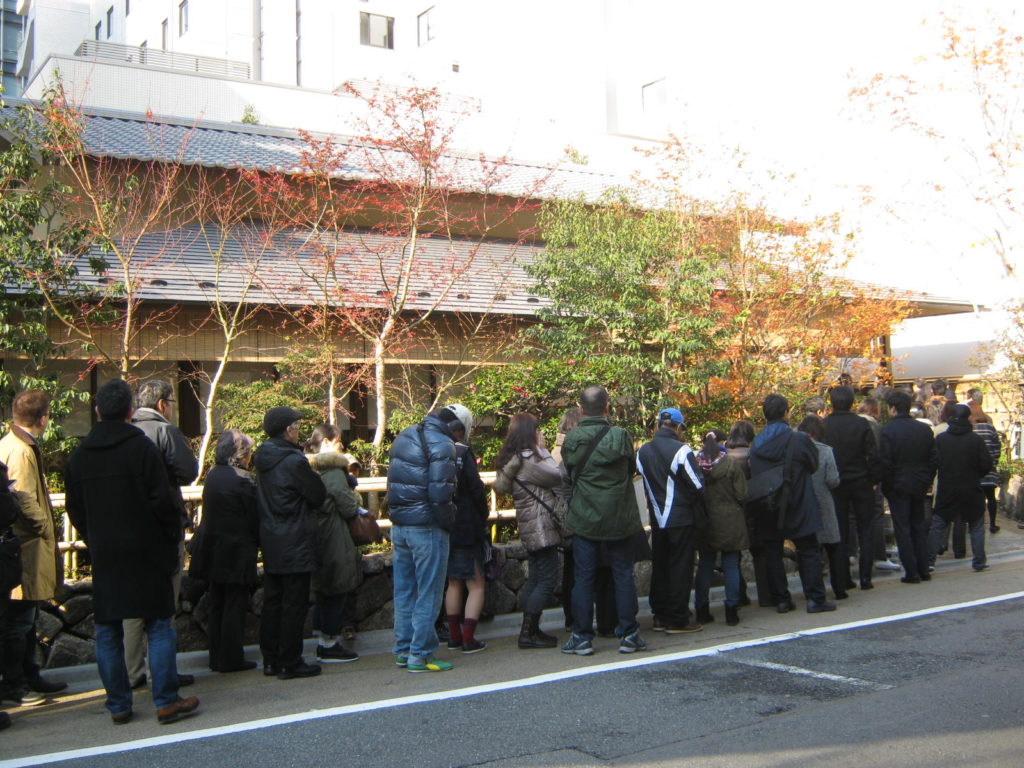Queuing is a part of Japanese habits. In rush hours, people stand in line to wait for trains to get on. At amusement parks such as Disneyland, people wait for one or two hours to get into popular attractions. Likewise, people are queuing up in front of restaurants or food shops to get in. Queues mean sales growth. My recent experience tells how the first customer attracts more people quickly in Japan.
A Customer attracts customers
On a Saturday afternoon, I was looking around dishes for dinner in the food section at the department store. I stopped by a cheese counter where a store woman was offering small pieces of cheese canapés for import cheese promotions. But no customers stopped to taste although a couple of people looking at cheese. “These are natural cheeses, just arrived from France.” With the voice of the store woman, I inadvertently picked up the canape from her tray. She smiled at me and handed me a small brochure for cooking recipes. When I looked back, I realized that several people came to the display and picked up canapés on the tray. One woman picked up one block of cheese and asked the store clerk about it. I seemed to have set something off single-handedly!
Follow crowds for a safe choice
In Japan, the gathering of people attracts more people. And people believe the majority choice is safe. One of the typical situations is a restaurant selection. When people do not have any ideas about which restaurants to go to, they typically go to restaurants with many customers. A long queue means a full restaurant. People join the row at the end without worrying about how long they will have to wait. But, people hesitate to be the first customer. Of course, people do not care if the shops have a full of customers or not when they have previous experiences with the shops. But people refer to preferences in the majority when they need to decide which products or services they buy for the first time. The crowds in front of shows are the sign of majority preference.
Majority influences in e-commerce
The phenomenon is equally – perhaps more – powerful in the world of e-commerce. For new products, consumers refer to the number of positive customer reviews and the popularity ranking. Five-star ratings on products at Amazon and Rakuten prompt purchase. Review sites such as @cosme for cosmetics and Tabelog for restaurants and food shops impacts purchase decisions for consumers, too. Furthermore, news about rankings of popular shops also the reference information for consumers to make the purchase decisions. Consumers believe that purchasers’ opinions are reliable for their own purchase decision making.
How to forecast purchase intentions?
In a market where the consensus seems more important than elsewhere, the whole notion of purchase intention for a product yet to be launched is inherently problematic. How are marketers to measure purchase intention in any meaningful way, when in the real world, purchase intention is so profoundly impacted by context?
In a typical pre-launch survey, we ask consumers about their purchase intentions after showing the concept and product usage experiences. And naturally, they express their opinions – system 2 – based on the information they have before them. Yet there’s a significant body of evidence to suggest that it’s system 1 judgments (are other people buying it?) that have a greater impact. How can this be factored into the measurement of purchase intent?
First customer and its news spreads
There is always a first customer for the creation of a trend. The trend prompts the majority of people to buy goods or services. Its first customer is an early adopter, often open to new products and services. Then, news media and SNS take the role of spreading information about new products or services. Of course, advertisements and sales promotions of sellers continue to influence the purchase of consumers. But the influence of news via social networks has become stronger than before.
Having the first customer and media for sparking the trend, how can we measure the purchase intention before launching new products or services onto the market? It is not easy to find out early adopters in Japan because generally, it’s less culturally acceptable to stand out. Another challenge is that effective media differs by segment.
Yet, there are early adopters, and media do spark trends. So, we should keep in mind that the first customer and media can play a critical role in driving purchase intentions for products or services.
All this suggests that we do not have any single measurement to forecast purchase intentions accurately.
Fake customers can be spotted
Some companies hire fake customers to extoll the virtues of their products or services. Some shops hire people to stand in line. These are known as sakura (cherry blossom).
But these fakes can be spotted, and the strategy can backfire; news can spread quickly and turn into a majority unfavourable evaluation. Reputations can suffer.
